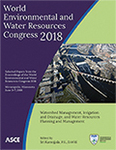World Environmental and Water Resources Congress 2018
Analysis of University Water and Energy Consumption to Support Management and Conservation Strategies
Publication: World Environmental and Water Resources Congress 2018: Watershed Management, Irrigation and Drainage, and Water Resources Planning and Management
ABSTRACT
Understanding various types of consumers and their respective consumption patterns, changes in their water and electricity consumption trends in response to conservation strategies, and identifying the most influential variables influencing water-electricity usage, are key to support management and conservation strategies. In this work, our goal is to characterize the consumption of five building classifications on a university campus, specifically, academic, education, dormitory, operations, and recreational buildings through daily water and electricity usage collected over several years. Water-electricity demand data grouped based on similar usage characteristics promotes the development of water-electricity demand models and informs utility managers on end-use consumption patterns to support management and conservation strategies. In this study, we have focused on data collection and analysis to identify common attributes of university buildings with similar observed performance over time. Water and electricity demand profiles for 71 buildings across UT Austin’s campus, were aggregated by considering several consumption representative features, such as per capita demand, demand per square foot, and the buildings’ functional purpose. Housing was found to be the largest and least efficient water consumer on campus and had the most consistent seasonal demand profiles. Research laboratories were found to be the largest and least efficient energy consumer on campus. Water demand seems to be heavily human influenced, while energy demand is more likely influenced by automated systems like heating, cooling, and lighting. This suggests that different strategies should be targeted for water and electricity conservation. Dormitory water-electricity demand was correlated with occupancy and time of the year (i.e. academic seasons). As building size and total demand increased the efficiency of water-electricity use per square foot decreased. The methods employed in this study indicate that simple feature extraction can yield insights into water-electricity demand profiles that can inform effective conservation strategies.
Get full access to this chapter
View all available purchase options and get full access to this chapter.
REFERENCES
Austin, U., 2018. UT Austin.Available at: https://utilities.utexas.edu/.
Blasio, B. & Lloyd, E., 2011. Water Demand Management Plan,
Blokker, E.J.M., Vreeburg, J.H.G. & Dijk, J.C., 2010. Simulating Residential Water Demand with a Stochastic End-Use Model. Water Resources Planning and Management, 136(February), pp.19–26.
Cominola, A.et al., 2015. Benefits and challenges of using smart meters for advancing residential water demand modeling and management: A review. Environmental Modelling and Software, 72, pp.198–214.
Cominola, A. et al., 2018. Segmentation analysis of residential water-electricity demand for customized demand-side management programs. Journal of Cleaner Production, 172, pp.1607–1619.
Miller, C. & Meggers, F.M., 2017. Mining electrical meter data to predict principal building use, performance class, and operations strategy for hundreds of non-residential buildings.
Nguyen, K.A., Stewart, R.A. & Zhang, H., 2013. An intelligent pattern recognition model to automate the categorisation of residential water end-use events. Environmental Modelling and Software, 47, pp.108–127.
Quiniones, G., 2016. BuildSmart NY EO88,
Vasak, M., Banjac, G. & Novak, H., 2015. Water use disaggregation based on classification of feature vectors extracted from smart meter data. In 13th Computer Control for Water Industry Conference, CCWI 2015. pp. 1381–1390.
Information & Authors
Information
Published In
World Environmental and Water Resources Congress 2018: Watershed Management, Irrigation and Drainage, and Water Resources Planning and Management
Pages: 152 - 161
Editor: Sri Kamojjala, Las Vegas Valley Water District
ISBN (Online): 978-0-7844-8140-0
Copyright
© 2018 American Society of Civil Engineers.
History
Published online: May 31, 2018
Authors
Metrics & Citations
Metrics
Citations
Download citation
If you have the appropriate software installed, you can download article citation data to the citation manager of your choice. Simply select your manager software from the list below and click Download.
